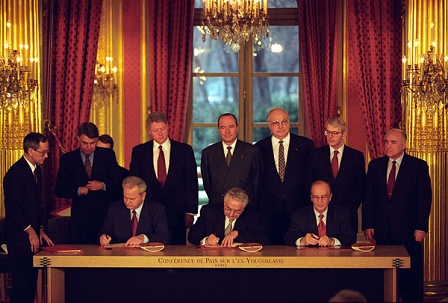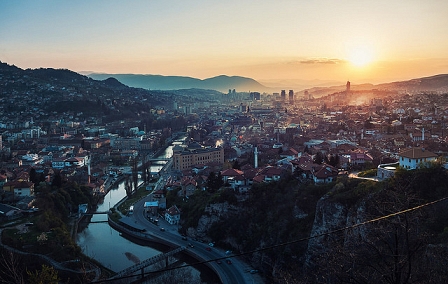Erstellt am: 21. 11. 2015 - 10:18 Uhr
Sarajevo, 20 years after the Dayton Peace Accords
by Enes Haracic
Reality Check Special:
This week’s Saturday Reality Check Special takes a look at the Dayton Peace Accords, how they have shaped the past 20 years and how Bosnians view their country today.
Saturday 21st November at 12 midday and afterwards seven days On Demand
It is hard for me to comprehend that it has been 20 years since the peace treaty that ended the fighting in Bosnia and Herzegovina and released Sarajevo from years of siege was agreed at a U.S. Airforce base in Dayton, Ohio.
I remember it vividly – watching on a quirky cathode ray television, a line of grim faces of politicians slowly drawing their signatures, inscribing their names in our history books.

Public Domain
At that moment very few of us whose destinies were being decided believed that these signatures would last longer than it takes the ink to dry, just like many earlier temporary, soon-to-be-broken ceasefires. To this day pessimists, critics and paranoiacs of all kinds still warn that ‘Dayton’ could still turn into the longest ceasefire in human history.
Years passed. The global landscape changed dramatically, marked with events conveniently nicknamed as nine-elevens, seven-sevens, thirteen-elevens. Perhaps it was deliberate that these labels exclude the respective year marks pointing to passing time.
Today the city of Sarajevo is not under threat from starvation and bombs. The only dangers are oblivion and economic downturn. And being marginalised, forgotten.
Reminiscing on 1995 and the spirit of the unbroken city which attracted global sympathy for surviving on its citizens’ insistence on normality and gigantic energy of pride, one remarkable thing stick out: the intense energy of Sarajevo wartime cultural scene.
Dark and literally underground. Shadows passing by and disappearing into the city tissue. Candle-lit basements made into the makeshift galleries, theatres and bars. It’s no wonder why international artists were the first to head visit Sarajevo during, and especially in the years immediately after, the siege.
The explosive (pun intended), raw energy of wartime bands (Protest, Sikter, SCH, to name a few), local cultural activists and artists immediately attracted the support of their global counterparts and helped launch Sarajevo into the global cultural sphere. It was a period which spawned numerous successful and less successful projects like today’s No1 regional film gathering the Sarajevo Film Festival, the now defunct “Futura” electronic music festival, the “Rock Under Siege” festival, the alternative theatre “Mess” and the up-and-coming “Sarajevo Jazz Fest”.
Film makers excelled, riding high on a wave of collective inspiration. Director Danis Tanovic won the Oscar Academy Award for his feature “No Man’s Land”. Statues of Berlin’s Golden Bear, awards form Cannes and other important film industry gatherings arrived for permanent residency in Sarajevo in those years. So was “Ars Aevi” - impressive modern art collection donated to the city by some of the most influential artists of today.
The most intense gigs I ever attended were during the war, most wild parties were just after. You should trust me on this one!
Ratni dernek na Akademiji, Sarajevo 1992
Posted by Selma Muftic Stevanovic on Tuesday, February 21, 2012
Venues were non-existent and in most cases fully improvised, but the vibe was victorious. The first ever club DJ party in Sarajevo was headed by FM4’s own DJs Smash, Tschamba Fii, Abraxas and Hannes Eder in the winter of 1999. From then on, DJs were booming their basses whenever and wherever possible, in spite of the acute lack of support infrastructure.
Celebration of peace in real terms. Obviously the focus then was on the positive aspects of the Dayton peace agreement. Unjust Peace, but still peace. Freedom. It lasted at least five years. For some of us, almost ten.
Then, somewhere along the timeline, as is bound to happen, the enthusiasm of the war generation slowly faded. Problems of bare existence, the monotony every day life and disappointment with social stagnation kicked in and the 15 years of adrenalin turned into a kind of generational cold turkey.
In the eyes of most young people and the general public, Dayton became the straitjacket of modern Bosnian society with all the flaws of a poorly written law-school homework that served its purpose quite well a decade ago. It was a solution to end the conflict without the effort needed to resolve its causes and single out those responsible. Dayton’s main flaw is its lack of mechanisms to channel the country’s energy in a progressive direction. Or any direction for that matter.
It imposed complex government structures which cemented the equilibrium of social and economic stagnation, exemplified by an EU funded, self serving “Office of High Representative”. Today, an utterly obsolete governing body, headed by a clueless Austrian political entertainer. Luckily, this parody in motion, too real to be funny, is distanced from the everyday life of local citizens. Or rather not distanced but just ignored.
As a result, the young generation seems to be lost without role models or sense of unity of any kind. It was just the right moment for the Balkan-infused consumer culture to introduce the Bosnian young generation to shopping malls and numerous copy-paste events and places, looks and behaviour patterns. TED broadcasts transformed the progressive city youth into better-late-than-never breed of young entrepreneurs and funemployed start-up innovators whose dreams are yet to be realised.
Sarajevo today is truly something new. Maybe not fully evolved, but at least fresh compared to a decade ago, a scene small enough to be avoided by commercialised culture and not loud enough to be important for the sub-cultural elites.
That’s a perfect recipe to make a place ordinary, or mediocre. But Sarajevo is not, and has never been, an ordinary place. Just ask the hordes of local students mixing with tourists packed into the tiny, smoked-up dive bars of Old Town Bascarsija throughout the year. Or climb the surrounding mountains with Sarajevans and hipster hikers from all around Europe touring the unspoiled nature.
I can personally vouch for the fact that Sarajevo is a great place for families with energetic toddlers. Parks, mountains and organic food are readily accessible and never too far in this overgrown village that acts as a capital of this non-EU circus at the gates of European Union. Interesting recent history that can still be sensed on Sarajevo streets, combined with cheap accommodation and good food makes Sarajevo one of the top tourist destinations from one year to the next.
The band Dubioza Kolektiv has achieved global fame by combining raw energy, daily politics and Balkan subculture. The band itself is the product of Dayton. Created by the post-war fusion of a hip-hop band from Central Bosnian city of Zenica and several members of Sarajevo wartime band scene, this band fused the right recipe to achieve their dreams of becoming the global festival attraction.
Culturally, today’s Sarajevo still struggles to escape the straitjacket of the country’s political system, but the city is already well on its way to putting itself confidently onto the cultural map of Europe. It deserves that much.
After all, something is always cooking in the Golden Valley.
Reality Check Special
This week’s Saturday Reality Check Special takes a look at the Dayton Peace Accords, how they have shaped the past 20 years and how Bosnians view their country today.
Saturday 21st November at 12 midday and afterwards seven days On Demand
Dieses Element ist nicht mehr verfügbar




